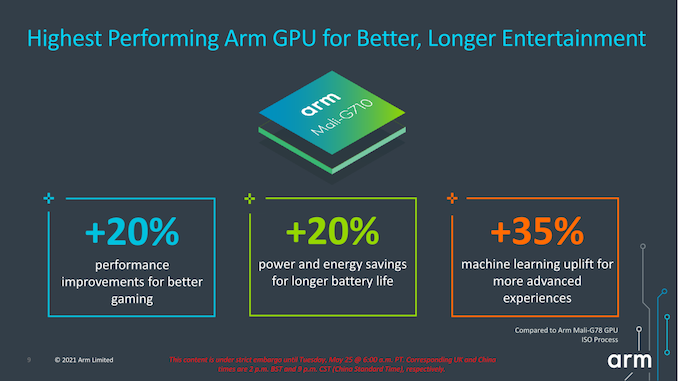Arm Announces New Mali-G710, G610, G510 & G310 Mobile GPU Families
by Andrei Frumusanu on May 25, 2021 10:00 AM EST
Alongside with today’s extremely large and comprehensive CPU line-up announcement including the new Cortex-X2, Cortex-A710, Cortex-A510, new DSU-110 and new interconnects, we’re seeing the announcement of Arm’s newest Mali GPU line-up. Similar to the CPU family, we’re also seeing an extensive line-up announcement with the new Mali-G710 flagship series, the G510 middle-range, and the new ultra-area efficient Mali-G310.
The new GPU series follows up in the same Valhall GPU family that was started back in 2019 with the Mali-G77 and seen minor improvements with the Mali-G78 in last year’s announcements and seen silicon adoption in this year’s SoC’s such as the Kirin 9000, Exynos 2100 or the new MediaTek Dimensity SoCs.
At the high-end, the Mali-G710 is a direct successor to the Mali-G78 and is a relatively straightforward generational improvement in terms of what it’s aiming for: the highest possible performance that Arm’s architects can achieve in a Mali GPU. The Mali-G610 is a branding exercise that differentiates the same microarchitecture as the G710 at lower core counts, aiming to aid partners to better differentiate flagship products from the “premium” segment.
The Mali-G510 is a successor to the 2019 Mali-G57 and is a major upgrade to Arm’s mid-range portfolio, bringing extremely large generational performance boosts as well as power efficiency gains over the predecessor.
Finally, the new Mali-G310 is a new Valhall based low-end entry that represents a multi-generation architectural bump over the old-in-the-tooth Bifrost based Mali-G31 and targets the low-end area-efficiency focused market where we see hundred of billions of low-cost devices and other embedded markets such as smart TVs.
As gross overview, the highlight today for most readers will be focused around the new Mali-G710 flagship GPU. The improvements that the company is promising is roughly a +20% boost in performance in a ISO-process node GPU configuration compared to a comparable Mali-G78 GPU. Similarly, at similar performance, the new GPU design promises a -20% reduction in power consumption and thus also energy efficiency gain.
Recently, Arm has also made a focus on Machine Learning on the GPU and here the new design is promising a larger +35% boost in performance.












30 Comments
View All Comments
mode_13h - Saturday, May 29, 2021 - link
Good points, but Imagination demo'd ray tracing many years ago. It'd be interesting to know if they had some unique tech, or if the implementation was just too limited for modern games.t.s - Tuesday, May 25, 2021 - link
"Conclusion & 1st Impressions" Last paragraph: "If those DTV markets hare numbers are accurate" -> 'hare' minus s.James5mith - Tuesday, May 25, 2021 - link
I think it was supposed to be market share, not markets hare.eastcoast_pete - Tuesday, May 25, 2021 - link
Thanks Andrei. Question about Imagination: did they have any design wins recently? It's been awfully quiet.ToTTenTranz - Tuesday, May 25, 2021 - link
Did Nvidia give up on purchasing ARM?If not, there's a bit of a white elephant in the room.
eastcoast_pete - Tuesday, May 25, 2021 - link
I believe that NVIDIA wouldn't want to have its precious CUDA cores "slumming" it in $ 100 smartphones, so they probably hang on to Mali just for this.brucethemoose - Tuesday, May 25, 2021 - link
If it make them money, why not?But there is the question of how low it can go. Would something much, much smaller than a Switch Tegra be competitive with low end Mali?
mode_13h - Wednesday, May 26, 2021 - link
You heard Mediatek is licensing Nvidia graphics IP? Granted, probably not in $100 phones, but maybe $250? I guess we'll see.BTW, you know CUDA cores are in their $100 Jetson boards and Nintendo Switch, right?
Wereweeb - Wednesday, May 26, 2021 - link
That's not how this kind of business works. No one knows what the future holds.Dahak - Wednesday, May 26, 2021 - link
Its still going through the regulatory checks, it will be at least a year before its finalized if its approved and even more it will be a few years on top of that before we see any nvidia IP offered / licensed like ARM's if Nvidia decides to do that.Just because they are acquiring ARM does not mean magically Nvidia's GPU IP will replace the current if at all